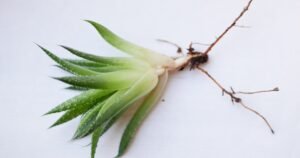Succulent Turning Brown and Soft causes:
- Sunburn
- Underwatering
- Pests
- Fungal diseases
- Insufficient nutrition
- Fertilizer
- Succulent dying after repotting
- Too much water
- Watering too often causes root rot
Succulents boast a reputation for being hardy plants, but they’re not resistant to problems. If your succulent is turning brown and soft, it’s displaying clear signs of distress. Often, these symptoms suggest overwatering, which can lead to root rot, a serious condition that can easily kill succulents.
The excess water makes the plant’s cells swell and burst, causing its root to turn brown and jelled. Additionally, succulents need well-draining soil and a pot with drainage holes to help prevent water from sitting at the bottom and causing root or stem rot.
Remedying Brown and Soft Succulents
Rescuing an overwatered succulent involves several steps. Firstly, stop watering the plant immediately and allow the soil to dry out completely. If the condition is severe, consider replanting the succulent in fresh, well-draining soil.
While repotting, inspect the roots carefully and remove any that are brown and mushy. It may also be necessary to remove any affected leaves or sections of the plant to prevent the rot from spreading.
After repotting, wait for a few days before you start watering again, and then adjust your watering schedule to prevent future problems. Remember, succulents are drought-tolerant plants that thrive in dry conditions, so it’s better to underwater than overwater.
Introduction
Succulents are beloved plants known for their resilience and ability to thrive in various environments.
However, one common issue that many succulent addict encounter is when their succulents start turning brown and soft.
This alarming transformation often raises concerns and prompts the need for immediate attention.
In this article, we will delve into the primary causes behind succulents turning brown and soft, exploring factors such as overwatering, insufficient sunlight, pest infestations, inadequate drainage, and root rot.
Understanding these causes is crucial to effectively addressing the problem and implementing appropriate remedies.

Overwatering: A Common Culprit
Overwatering is a frequent cause of succulents turning brown and soft.
Succulents are adapted to survive in arid environments with infrequent rainfall, storing water in their leaves, stems, and roots.
When they receive excess water, the roots become saturated, leading to an inability to absorb oxygen.
Consequently, the roots suffocate and start to rot, resulting in the plant’s leaves turning brown and feeling soft to the touch.
The excess moisture also creates an ideal environment for harmful bacteria and fungi, exacerbating the issue.
To prevent overwatering, it is essential to understand the specific water requirements of your succulent species.
Proper watering techniques, including allowing the soil to dry out between watering and adjusting the watering frequency based on the season, can help maintain the health of your succulent and prevent browning and softening.
Insufficient Sunlight: Affecting Succulent Health
Succulents are sun-loving plants that require ample sunlight to thrive.
When succulents do not receive adequate sunlight, they may become weak and susceptible to browning and softening.
Insufficient light disrupts the photosynthesis process, where the plant converts light into energy.
Without enough energy, the plant cannot maintain its structure and health, leading to a decline in its overall condition.
To ensure your succulent receives enough sunlight, place it in a location where it can access at least six hours of indirect sunlight per day.
If natural light is limited, consider using artificial grow lights specifically designed for plants to supplement their light requirements and maintain their vitality.

Pest Infestations: Hidden Dangers
Pest infestations can also cause succulents to turn brown and soft.
Common pests such as aphids, mealybugs, spider mites, and scale insects feed on the plant’s juices, weakening its structure and affecting its overall health.
These pests can be challenging to detect initially, as they often hide in crevices or beneath the leaves.
Regularly inspect your succulents for signs of pests, such as discolored or deformed leaves, small insects, or sticky residues.
If you detect an infestation, promptly treat your succulent with insecticidal soap or neem oil to eliminate the pests and prevent further damage.
Inadequate Drainage: A Plant’s Lifeline
Inadequate drainage is another factor that can lead to succulents turning brown and soft. Succulents require well-draining soil to prevent water accumulation around their roots.
When the soil retains too much moisture, the roots suffocate, causing them to rot and turn brown. Proper drainage allows excess water to escape, promoting a healthy root system and preventing the onset of root rot.
Ensure that the pots or containers you use for your succulents have drainage holes, allowing water to flow out freely.
Additionally, use a well-draining soil mix specifically formulated for succulents to provide the ideal environment for root health.
Root Rot: A Silent Menace
Root rot is a serious condition that can result from a combination of overwatering and inadequate drainage.
It occurs when the roots of a succulent become damaged or decay due to excess moisture, eventually turning brown and mushy.
As the roots deteriorate, the plant loses its ability to absorb nutrients and water, leading to browning and softening of the leaves.
To prevent root rot, be mindful of your watering habits and choose well-draining soil.
If you suspect root rot, carefully remove the affected parts of the plant, allow the remaining healthy roots to dry, and replant the succulent in fresh, well-draining soil.
Final Thoughts: Nurturing Healthy Succulents
Understanding the causes and remedies for succulents turning brown and soft is crucial for successful succulent care.
Regular inspection, appropriate watering, sufficient sunlight exposure, pest prevention, and proper drainage are all fundamental to maintaining the health and longevity of these resilient plants.
By taking these factors into account, you can ensure your succulents remain vibrant and healthy, enhancing their beauty and contribution to your home or garden decor.
Conclusion
Succulent turning brown and soft can be distressing for any plant enthusiast, but understanding the underlying causes and implementing appropriate remedies can help nurse your succulent back to health. Overwatering, insufficient sunlight, pest infestations, inadequate drainage, and root rot are common culprits, each requiring specific approaches for mitigation. By following proper care techniques and providing the necessary environmental conditions, you can ensure longevity and vibra.
FAQs
Why is my succulent turning brown and squishy?
Your succulent might be turning brown and squishy due to overwatering, causing root rot. Additionally, insufficient sunlight, pest infestations, or inadequate drainage could be culprits. Each of these factors disrupts the plant’s health, causing succulents to turn brown and soft, leading to a brown and squishy appearance. Monitoring watering, ensuring ample sunlight, checking for pests, and using well-draining soil can help address these issues.
How do you fix a succulent that turns brown?
To fix a brown succulent, first identify the root cause. If it’s due to overwatering, reduce watering frequency and ensure the soil is dry before watering again. If the light is the issue, the succulent turns brown and soft, relocate the succulent to a sunnier spot or use artificial grow lights. For pests, treat the plant with insecticidal soap or neem oil. If drainage is the problem, report the succulent in well-draining soil and a pot with drainage holes.
How do you fix soft succulent leaves?
Soft succulent leaves are often a sign of overwatering. To fix this, allow the soil to dry out thoroughly before the next watering. Improve drainage by repotting the plant in a well-draining soil mix and ensuring the container has enough drainage holes. If the problem persists, the succulent turns brown and soft; you might need to remove and replant the healthy parts of the succulent in fresh soil.
Why are My Succulents Turning Brown?
Succulents turn brown for various reasons, including overwatering, insufficient sunlight, pest infestation, inadequate drainage, or root rot. Identifying the specific cause allows you to take appropriate corrective measures to restore your succulent’s health, such as adjusting watering habits, providing more light, treating for pests, or improving soil drainage.











